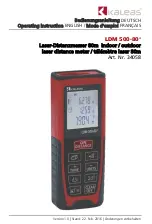
18
ADDITION OF SURFACTANT
A surfactant addition works by changing the surface tension of the water. In this way bubbles are
released from the sample. This method is effective in samples that are supersaturated with air.
The procedure consists in the addition of a drop of surfactant in the cuvette before adding the sample
to be analyzed.
A convenient surfactant to use for degassing is Triton X-100.
Warning
: Changing the surface tension will cause a rapid settling of particles that cause turbidity.
To avoid this problem, analyze the sample as soon as possible.
Do not shake the sample vigorously because the surfactant may foam. If you are using the same
cuvette, rinse it before adding a new sample in order to avoid surfactant accumulation.
Surfactant contribution to the turbidity readings is negligible.
Note
: Surfactant addition should be used for degassing only when other methods are ineffective.
USE OF AN ULTRASONIC BATH
Ultrasonic waves are very effective in removing air bubbles from samples. However, ultrasonic waves
should be used with care because they can alter sample turbidity characteristics by modifying the
shape and size of particles which cause turbidity. The ultrasonic waves can also break the existing air
bubbles, leading to a complication of the degassing process.
In order to avoid excess application of the ultrasonic waves you can apply ultrasound until all visible
air bubbles are removed, and then measure the sample turbidity. This is the most common procedure
for degassing.
If you are not sure that all air bubbles were removed, apply ultrasonic waves again for a short period
of time and then measure the turbidity. Repeat this procedure until the turbidity is increasing instead
of decreasing, a sign that turbidity of the sample was altered.
In order to degas a sample fill a clean cuvette with sample and immerse it (1/2 to 2/3 immersed)
in an ultrasonic bath. Follow the degassing procedure described above. Only after the degassing
procedure is finished can the cuvette be capped.
HEATING THE SAMPLE
Use of heat to remove air bubbles, although very effective in some cases, should be handled with care
because it can alter the turbidity of the sample. When heating a sample, the volatile components
from the sample can vaporize, the suspended components can dissolve or the sample characteristics
can change.
Therefore, the heating procedure should be used with extreme care.
The best way is to use a warm water bath and immerse the cuvette with sample into the bath. Heat
the sample only until the visible bubbles are removed.
Note
: Always cool the heated sample to the original sample temperature before measurement.
The heating procedure can be used in combination with vacuum or ultrasonic wave application for a
more effective air bubble removal.
















































